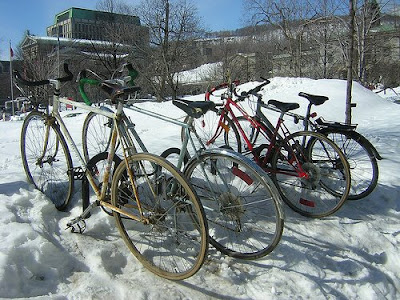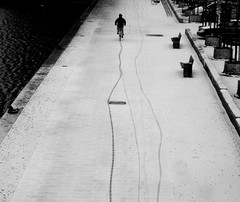

A few days ago I posted about a bike brand that made lovely bikes and then, for reasons I don’t understand, had a page about ‘recommended clothing’. The post illicited many responses, which is always great. Many people, however, wandered off onto tangents. Let’s tidy it up a bit by shovelling the proverbial footpath. Firstly, yes yes yes, we all all aware that Minneapolis is cold in the winter. Although, having spent most of my childhood - for reasons beyond my control - growing up in Calgary, Canada, Minnesota winters are girlie winters to me… :-).
And like the Montréalers on the blog, others know too well the chill of winter. One of the chaps behind Larry vs Harry cargo bikes used to be a bike courier in Montréal, in the winter, and he couldn't recognize the need for such Rambo gear in the previous post.
'My winters are are colder than your winters' is not the point of the post or anything to do with what I'm trying to say.
Many visitors to this blog ride their bikes or are involved with bike policy in cities around the world. Those of you in North America are in a minority. It is in everybody's interest to do whatever we can to change that to a majority, or at the least increase the numbers. Urban cycling is a product and products should be sold properly. If you want people to buy a product, it is generally not a good idea to overcomplicate it. When you buy shampoo, you usually assume that you'll just have to squirt some in your hands and lather it into your hair. You may not choose to buy a shampoo that comes complete with two bottles that require you to mix two carefully-measured liquids together [measuring spoons included] with a custom-made mixing apparatus [batteries not included] after which you insert the completed mixture into the Shampoo Application Tool © [please use protective glasses!] that applies the shampoo onto your scalp. Pay $30 extra and get the newly improved Lather Removal Kit! So while I may think someone who buys the above shampoo kit to be quite odd. - I completely respect those who ride long distances each day. - I used to race so I can appreciate the joy of bike racing or bike touring. - I realise that some people live - and ride - in climates that are colder than average or in areas with a hillier geography than average. I love everyone mentioned above. We all do. However, for the majority out there that needs inspiration, very few of the points above are good marketing. They are quite useless in fact. They all highlight that cycling can be strenuous and difficult and this is what many companies have been trying to sell for decades in North America and elsewhere. Long distances? 50% of Americans live within 8 km of their workplace. That's a lot of Americans. 85% of Americans use their car for journeys under 5 km. Certainly, many of these people don't have bike-friendly routes to use, but if only 10% of the above numbers were encouraged to ride, think of the difference that would make. Or even 5%. Let's face it. In order to ride a bike you need... a bike. Period. Anybody who tells you that you need more than that wants to sell you something. Nothing wrong with merchants wishing to sell you products. That's as old as homo sapiens. It's economics. I just choose to criticise this prevalent over-complication of a simple issue.One of our readers, the always interesting Adrienne, wrote in the comments that:
"What if every person in America decided to ride bikes? That would be wonderful! What if everyone of them decided to do it in helmets and lycra and clips? Would that make it less so?"
On paper, it would be fantastic. I believe, though, that no matter how you twist it or turn it, the majority will never end up as 'bicycle enthusiasts'. Just look at the cities that are moving forward these days. Portland isn't filled with lycra-clad, Oakley-glassed, carbon-fibered cyclists. There are many average people on average bikes. Look at New York City - the day is coming when New Yorkers Who Ride a Bike will outnumber New York Cyclists. Look at Paris. Nowhere on the planet has seen such a massive increase in the number of bikes on the streets in such a short amount of time as in the French capital. European cities - both those with great numbers of people on bikes and those who are booming - have traditionally avoided the overcomplication factor and they are reaping the benefits on all levels of society. Reduced traffic and pollution, better health standards, fewer sick days for citizens... and so on. People just want to be inspired to ride a bike and that's what we should be focusing on. Let the merchants adapt to the 'New Wave of Cycling' instead of trying to get the general population to adapt to the tiresome 'Cycling is a Sport' mantra.
Here's another comment from a reader who has recently embraced urban cycling in New York, as posted on the piece about New York's increase of cyclists.
"It is true, yes, in New York although it's harder to see the change from my perspective as a participant in it (started riding daily mid-summer). There has been some mild resentment of the new riders from established "tribes", but I think even they realize that normalized cycling is better for all. American cycling lore (the gear, the outfit, the helmet) will continue to be passed down through the athletic segments (currently, half of my ladyfriends are "triathletes") but submission to that lore among everyone else has been broken with surprising ease. It makes me think that the massive conformity displayed previously was more a result of self-selection (adults that want to compete in athletic events, or place themselves in front of speeding cars with no support from infrastructure or law) than any part of our nature, which is a huge relief!"Encouraging news which backs up my postulate about how most people aren't going to end up in lycra or on the membership rosters of bicycle clubs. So what should be tell people who live in cold climates? Should we present them with a long, expensive list of 'gear' that they need to purchase? Will that encourage Mr Average and his family? Not. Pierre, from Montréal, wrote a comment about what he wears in the dead of winter and I thought about what I wore. People who live in a cold city probably own clothing that they wear each and every day and which is suitable for the climate. What's wrong with those clothes? They already own them and use them. There is absolutely nothing to stop them from wearing them on a bike - unless you want to sell them something, of course. When a snowstorm hits or the temperature falls, this is what I wear. I ski and snowboard, so I own a ski jacket. I have ski gloves. I have winter boots. I supplement these things with a scarf and a flat cap. This is the same clothing I take when I drive an hour and half to ski/snowboard in Sweden or when I head to the Alps. This is the same clothing I'd wear if I went to Minneapolis or Montréal in the winter. On or off a bike.
Most people have clothes like this. It is enough. All they need is a bike. Spread the word.








